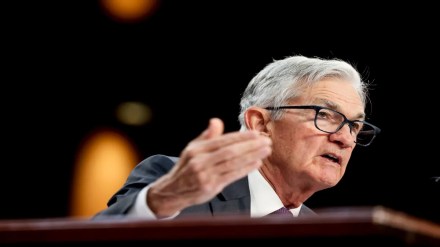Jerome H. Powell, Chair, Board of Governors of the Federal Reserve System, will again face some questions from the lawmakers during a hearing on “The Semiannual Monetary Policy Report to the Congress.
Fed Chair Powell is scheduled to testify before the Senate Banking Committee today at 10 am ET. The Hearing and Powell’s speech can be watched at the banking.senate.gov website. On June 24, Powell gave his testimony to the Committee on Financial Services, where he presented the Fed’s semi-annual monetary report to Congress.
Fed Chair Powell has refused to budge in response to Trump’s call for interest rate cuts. In a testimony to the House Finance Committee on June 24, Powell reiterated what he has been saying for almost six months now.
Powell informed Congress that the Fed will maintain its stance of keeping the key fed funds rate unchanged until the Fed has a better understanding of President Trump’s tariff policy and its impact on consumer prices.
Powell’s two-day testimonies to Congress happened amidst an increasingly heated conflict between Powell and Trump over interest rates. President Trump has repeatedly demanded that the Fed reduce rates, citing recent economic data indicating a relatively low level of inflation.
Despite Trump’s threats on social media and in interviews, Fed officials have been hesitant to cut interest rates due to their independence from presidential control.
In the statement to Congress, Powell said, “Despite elevated uncertainty, the economy is in a solid position. The unemployment rate remains low, and the labor market is at or near maximum employment. Inflation has come down a great deal but has been running somewhat above our 2 percent longer-run objective.”
Powell was conspicuous on the incoming data and remarked about the degradation of numbers related to GDP. “Following growth of 2.5 percent last year, gross domestic product (GDP) was reported to have edged down in the first quarter, reflecting swings in net exports that were driven by businesses bringing in imports ahead of potential tariffs. This unusual swing has complicated GDP measurement,” said Powell.
On the impact of tariffs. Powell sounded more confident. “Policy changes continue to evolve, and their effects on the economy remain uncertain. The effects of tariffs will depend, among other things, on their ultimate level. Expectations of that level, and thus of the related economic effects, reached a peak in April and have since declined. Even so, increases in tariffs this year are likely to push up prices and weigh on economic activity,” said Powell.
“Near-term measures of inflation expectations have moved up over recent months, as reflected in both market- and survey-based measures. Respondents to surveys of consumers, businesses, and professional forecasters point to tariffs as the driving factor,’ added Powell.
The pressure from the White House could increase. Powell’s stance differs from two other Fed rate-setting committee members, Christopher Waller and Michelle Bowman, who are leaning towards a rate cut in July.
Trump is expected to announce additional tariffs in the coming months, including those on pharmaceuticals, computer chips, lumber, steel, aluminum, and foreign cars, and to end his 90-day pause on his “Liberation Day” reciprocal tariffs.
Powell remains resolute in maintaining rates until inflation decreases, with the US Fed and markets waiting until September to determine if inflation in June, July, and August has actually been tamed in the face of reciprocal tariffs.
The recently published ‘dot plot’ indicates 50bp of cuts for the second half of 2025. The next three FOMC meetings take place on July 29-30, September 16-17, and October 28-29. The monthly CPI data is released mid-month, giving time for the US Fed officials to decide on the rate cut decisions. The next US CPI data for June 2025 are scheduled to be released on July 15.
